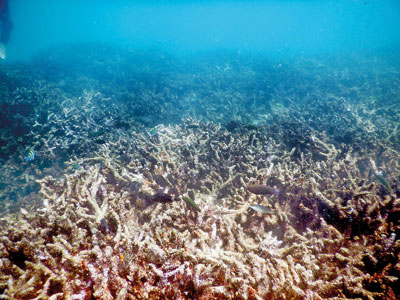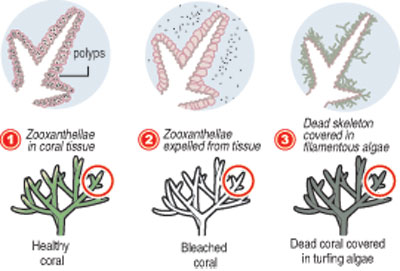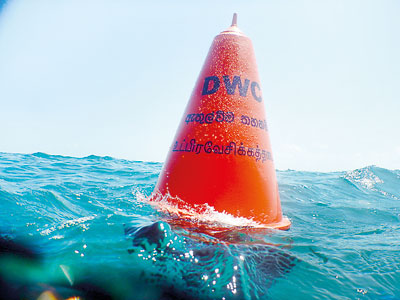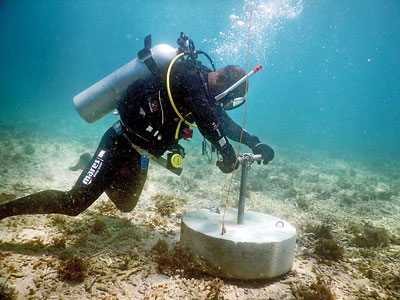News
Floating lifeline to rescue dying Bar Reef
Scientists hope a line of buoys enclosing threatened sections of the Bar Reef will provide a lifeline for the dying marine sanctuary.

Dead reef
Bar Reef, off Kalpitiya, is one of the marine sanctuaries affected by catastrophic coral bleaching.
Marine activists who deployed a number of floating buoys demarcating two sections of Bar Reef from March 26-29 to keep human activities at bay and assist the reef’s recovery, say a united front is vital for the success of such projects.
“Evidence-based science, support from the community and the right attitude are the combinationthat will work to conserve Sri Lanka’s rich biodiversity,” marine researcher Dr. Sewwandi Jayakody said.
Bar Reef Marine Sanctuary covers 306.7 sq km of coral reef and is considered the healthiest coral reef area in Sri Lanka, with live coral cover of around 80 per cent of the underlying layer, until it was hit by a warm oceanic current in 1998 that also destroyed other coral reefs around the island.
Bar Reef recovered to some extent from this destruction, but was again damaged by another large coral bleaching event in 2016.
“On some areas of Bar Reef, the live coral cover had fallen lower than 2 per cent,” marine researcher Prasanna Weerakkody revealed.
Dead corals have turned into rubble that moves with strong currents, impeding coral building-organisms from settling in and thus slowing the recovery of the reef.
Human activities such as fishing on the reef further disturb the recovery process, so marine biologists agreed that keeping the area free of such activity could hasten its recovery.
Coral reefs in and around the southern coast at Hikkaduwa, Rumassala, Unawatuna and other places have not recovered from the 1998 bleaching event.
Mr. Weerakkody suggested that one factor that had contributed to the partial healing of the coral reefs in the northern, north western and eastern seas was that the war had restricted seagoing activities in these areas. This prompted the notion to keep an area of the damaged southern reef protected from human activities.
Most of the coral reefs are located adjacent to beaches, but the Bar Reef is farther from the shore and is fully submerged. In some parts, the Bar Reef is nine metres (30 feet) underwater but there are shallower areas just a metre below the surface that are affected by human activity, and a section measuring half a sq km and another smaller section have been “fenced off” by buoys.
Mr. Weerakkody explained that setting up the buoys had to be carefully-planned as they had to be fixed firmly underwater so that they would not move around and damage the coral.
The laying of the buoys was carried out by the Ocean Resources Conservation Association (ORCA) and the Department of Wildlife Conservation under the Environmental Sensitive Areas project which is implemented by the Ministry of Mahaweli Development and Environment and is supported by the UNDP with funding from the Global Environment Facility (GEF).
The critical factor is how different parties joined hands to protect a natural resource, said Dr. Jayakody, senior lecturer at Wayamba University, which is also involved in this project.
“This has been a case where scientists, policy-makers, funders and even communities came together for the protection of a natural resource,” Dr. Jayakody said.
The co-operation of ORCA, the Wildlife Department, the navy, the UNDP, the International Union for the Conservation of Nature (IUCN), district and divisional authorities and community members of Kandakuliya, Kudawa and Kalpitiya was the crucial factor in the success of this assignment, she said.
The project team had involved the community by educating people on the importance of the Bar Reef for their livelihood. The coral reefs act as fish breeding grounds, so a healthy reef would bring up fish stocks that would help fishermen. They were told a healthy coral reef would be a jewel for tourist operators and this too would benefit the community,
As Bar Reef is difficult to monitor, being at a distance from land, Dr. Jayakody is calling on visitors to the reef and others to respect the buoy boundaries as the success of the project would depend on this.
Coral expert Arjan Rajasuriya, who co-ordinates the IUCN’s coastal and marine programme, also emphasised the importance of isolating sections of the reef from human activity and obtaining community support.

Buoy marking

A diver sets up anchor for a buoy

